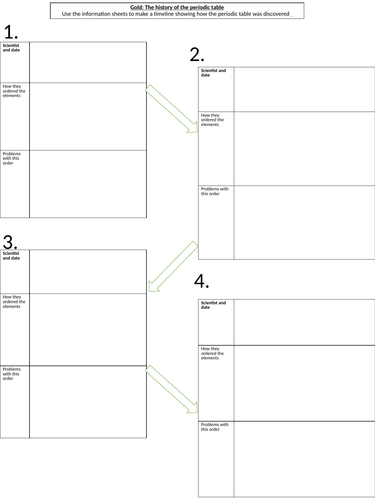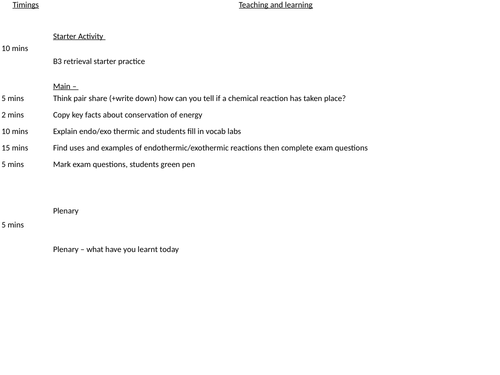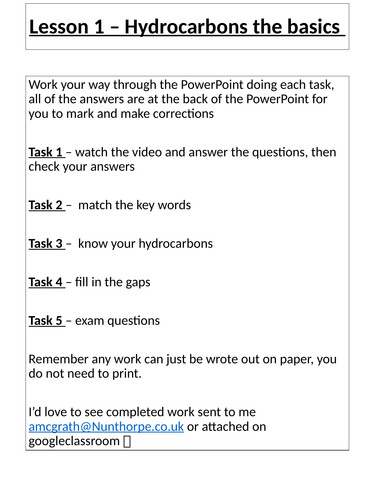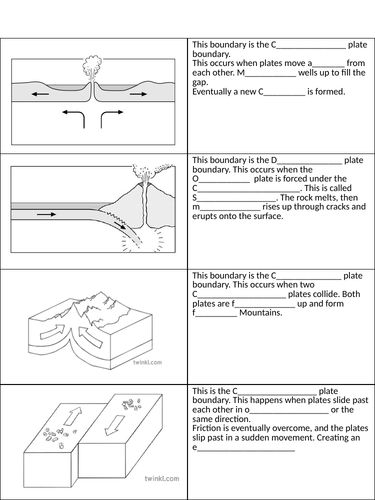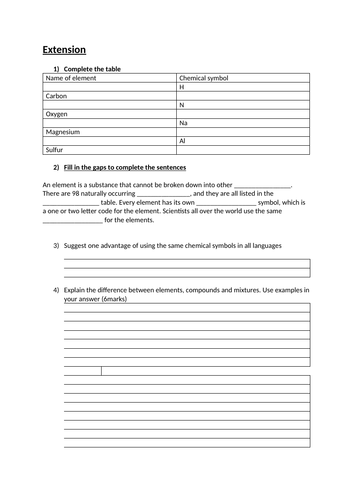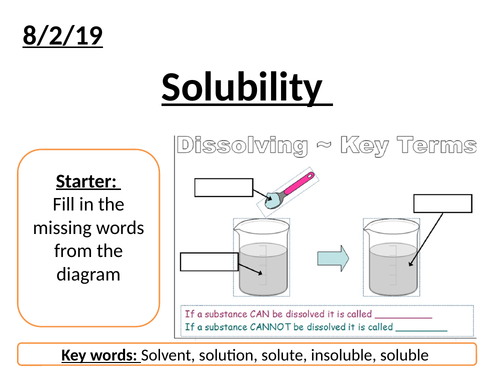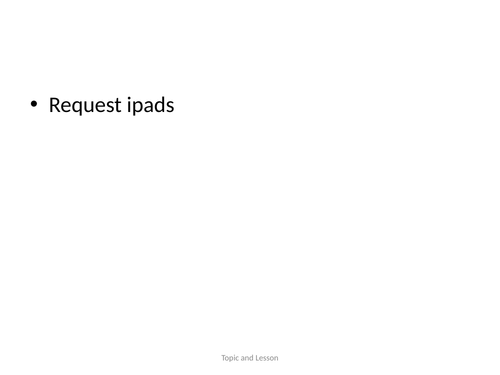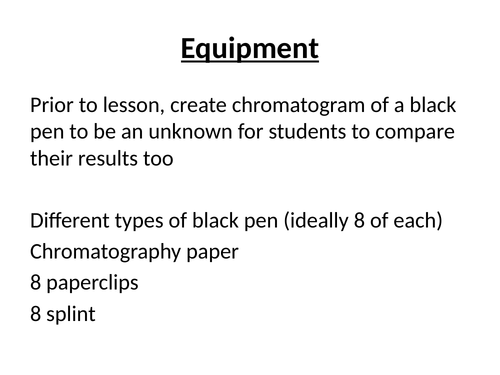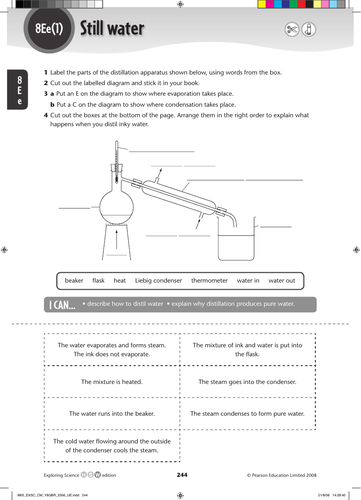
123Uploads
27k+Views
8k+Downloads
Chemistry

History of the periodic table KS3
Differentiated retrieval starter questions.
Go through answers
Main –
Add periodic table to key words, watch video about history of periodic table
Using differentiated sheets, create timeline of history of the periodic table
Label modern periodic table and answer questions
Plenary
Carton elements – identify the carton character

C7.1 exothermic and endothermic reactions
Aimed at foundation students - Does not include required practical
Starter - B3 retrieval starter practice
Main –
Think pair share (+write down) how can you tell if a chemical reaction has taken place?
Copy key facts about conservation of energy
Explain endo/exo thermic and students fill in vocab labs
Find uses and examples of endothermic/exothermic reactions then complete exam questions
Mark exam questions, students green pen
Plenary
Plenary – what have you learnt today

Plate boundaries - differentiated tasks
Low ability - fill in the gaps activity with the first letter of each missing word
Middle ability - fill in the gaps
High ability - explain themselves

Elements
Appropriate for KS3
Recall starter, followed by an introduction to elements and particle diagram
Including a mini practical to get students thinking about key properties of elements

Lab equipment worksheet
A worksheet with common lab equipment for students to fill in as they are introduced to the lab.

Compounds
Suitable for KS3
Includes:
Introduction to compounds
Particle diagrams of elements and compounds
Naming compounds with two and three elements
Mini practical to compare elements and compounds
All answers included

Chemistry paper one revision
Complete paper one Chemistry revision following the AQA trilogy specification.
Parts for higher only are highlighted.
work booklets to accompany powerpoint, which can be used in lessons or revision sessions.
Questions embedded in the powerpoint with answers for students to practice and focus on key concepts
My year 11s have found these benefical.

Elements and compounds KS3
Elements, compounds and mixtures- Some resources are from other areas on TES
Targeted at year 8 mixed ability class.
Starter: 5 minutes timed activity, challenege to see how many words students can make from the periodic table
Main: Go over definitons of elements/compounds/mixtures.
Then use these definitons to identify which particle pictures are elements/compounds
Go over rules of particle diagrams, then a choice of higher or lower ability sheet.
Higher ability sheet: students need to draw particle diagrams
lower ability sheet: students need to identify the correct particle picture
Extension: Worksheet, including tasks such as identifying elements, a fill in the gaps activity, 6 mark practicce question to explain the difference between elements/compounds/mictures
Plenary: Break the code using the periodic tab;e

Filtering and evaporation KS3
Aimed at mixed ability year 8 - Some resources from TES
L1 - Starter: thinking about what sea water contains
Main: Think pair, share how to separate sea water
introduce key words
write a method/risk assessment for practical
Plenary: particle diagram of what happens during filtering
L2 - Main label equiptment in the diagrams and mark
Main: complete rock salt practical
Differntiated bronze/gold worksheets for students to work their way through
Plenary: one thing students learnt today
Marking sticker provided for the practical, if you wish to level the students work

Dissolving KS3
Aimed at mixed ability year 8 class
Starter: Add key terms to diagram, using key words for the lesson
Main: Define key words and explain solubility
Practical: see if different compounds are soluble or not
Then draw particle pictures of what happens when a substance is dissolving
Plenary: Tweet one thing students learnt today

Fractional distillation KS3
Aimed at a mixed ability year 8 class
Starter: work out the link between the pictures
Main: Explain what crude oil is and what fractional distillation is
Watch video, answer questions, green pen mark questions
Complete level 1/2/3 worksheets explaining fractional distillation
Extension: research task linking SMSC and crude oil
Plenary: What problems would we encounter if we banned all crude oil now

Melting points KS3
Aimed at mixed ability year 8 class
Starter: which chocolate do you think is the most pure?
Main: explain what is meant by pure
carry out a practical to melt different chocolates to work out which is most pure and how we know that
plenary: questions to evaluate the practical

Chromatography KS3
Aimed at a mixed ability year 8 class
Starter: summaries what separation techniques students have learnt about so far
Main: Define and explain chromatography
Show students a chromatogram and discuss what we can learn from it
Practical: carry out an investigation to see who wrote the note, work sheet to complete whilst chromatogram is developing
Extension: What effect does each mistake make
Plenary: Exam question

Solubility at different temperatures KS3
Aimed at mixed ability year 8 class
Starter: Write a hypothesis for what students think will happen to the amount of a solute that can dissolve as temperature increases
Main: Practical, have different water baths, see how much sodium bicarbonate dissolves at each temperature
Record results on worksheet
Differentiated worksheet higher or lower ability. Once completed practical evaluation and conclusion on each practical. Different tasks for higher and lower ability students

Simple Distillation KS3
Aimed at mixed ability year 8 class
Starter: would you drink dirty water, how do you think you could clean it?
Main: SMSC link to how many people dont have clean water, fill in SMSC grid based on video
Explain simple distillaation and equiptment, label diagram of equiptment
Watch distillation demo
Bronze/ Gold task to explain distillation
Extension task available on powerpoint
Plenary: Exam question
Bundle

Separation techniques KS3
Bundle of lessons for year 8
L1 - elements compounds mixtures
L2 - Dissolving
L3 - Solubility
L4 & 5 - filtering and evaporating
L6 - Melting points
L7 - Simple distillation
L8 - Fractional distillation
L9 - Chromatography

C1.1 atoms
Aimed at a mixed ability year 9 class. Some worksheet from other areas on TES
Starter
Stick in objective sheets for this topic, also stick in common formulae sheets
6 true or false questions – green pen mark
Main –
Think, pair, share – what is an atom? Share ideas, write a sentence to explain what an atoms is. Extension task to label an atoms (level 6 objective) but there is a lesson on the structure of the atom later in this topic
Copy definitions for element/compound/mixture onto worksheet. Then cut up pictures and decide if they are a compound element of mixture
Extension: find the element to spell the cartoon characters worksheet
Identify atoms/elements and name formula worksheet - green pen mark
Extension: write the name of the formulae
Plenary
Whiteboards out, write down the symbol for the elements I shout

C1.2 Chemical equations
Aimed at a mixed ability year 9 class
Worksheets are from TES
Starter Activity
Answer starter questions
Main –
Go through state symbols, make a note of what each means
Explain the conservation of mass – need to write down the defintions
Stretch: why do some reactions appear to gain/lose mass
Go through steps on how to balance equations. Supporting worksheets to build up. Make sure there is an emphasis on what the ‘big’ and ‘little’ numbers mean. Do examples at each step, then get students to complete the rest
Extension sheet of harder equations to balance for students flying through
Plenary
Plenary – make rules for balancing equations

